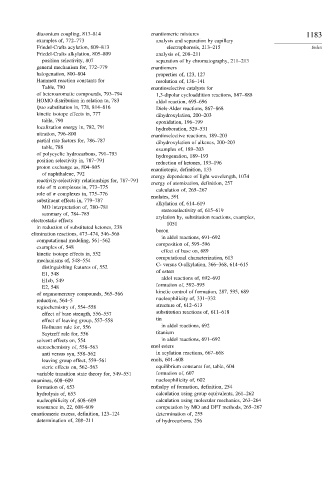Page 1196 - Advanced Organic Chemistry Part A - Structure and Mechanisms, 5th ed (2007) - Carey _ Sundberg
P. 1196
diazonium coupling, 813–814 enantiomeric mixtures 1183
examples of, 772–773 analysis and separation by capillary
Friedel-Crafts acylation, 809–813 electrophoresis, 213–215 Index
Friedel-Crafts alkylation, 805–809 analysis of, 208–211
position selectivity, 807 separation of by chromatography, 211–213
general mechanism for, 772–779 enantiomers
halogenation, 800–804 properties of, 123, 127
Hammett reaction constants for resolution of, 136–141
Table, 790 enantioselective catalysts for
of heteroaromatic compounds, 793–794 1,3-dipolar cycloaddition reactions, 887–888
HOMO distribution in relation to, 783 aldol reaction, 695–696
Ipso substitution in, 778, 814–816 Diels-Alder reactions, 867–868
kinetic isotope effects in, 777 dihydroxylation, 200–203
table, 790 epoxidation, 196–199
localization energy in, 782, 791 hydroboration, 529–531
nitration, 796–800 enantioselective reactions, 189–203
partial rate factors for, 786–787
dihydroxylation of alkenes, 200–203
table, 788
examples of, 189–203
of polycyclic hydrocarbons, 791–793
hydrogenation, 189–193
position selectivity in, 787–791
reduction of ketones, 193–196
proton exchange as, 804–805
enantiotopic, definition, 133
of naphthalene, 792
energy dependence of light wavelength, 1074
reactivity-selectivity relationships for, 787–791
energy of atomization, definition, 257
role of complexes in, 773–775
calculation of, 265–267
role of complexes in, 775–776
enolates, 591
substituent effects in, 779–787
alkylation of, 614–619
MO interpretation of, 780–781
stereoselectivity of, 615–619
summary of, 784–785
arylation by, substitution reactions, examples,
electrostatic effects
1051
in reduction of substituted ketones, 238
boron
elimination reactions, 473–474, 546–568
in aldol reactions, 691–692
computational modeling, 561–562
composition of, 595–596
examples of, 548
effect of base on, 689
kinetic isotope effects in, 552
computational characterization, 613
mechanisms of, 548–554
C- versus O-alkylation, 366–368, 614–615
distinguishing features of, 552
of esters
E1, 548
aldol reactions of, 692–693
E1cb, 549
formation of, 592–595
E2, 548
kinetic control of formation, 287, 595, 689
of organomercury compounds, 565–566
nucleophilicity of, 331–332
reductive, 564–5
structure of, 612–613
regiochemistry of, 554–558
effect of base strength, 556–557 substitution reactions of, 611–618
effect of leaving group, 557–558 tin
Hofmann rule for, 556 in aldol reactions, 692
Saytzeff rule for, 556 titanium
solvent effects on, 554 in aldol reactions, 691–692
stereochemistry of, 558–563 enol esters
anti versus syn, 558–562 in acylation reactions, 667–668
leaving group effect, 559–561 enols, 601–608
steric effects on, 562–563 equilibrium constants for, table, 604
variable transition state theory for, 549–551 formation of, 607
enamines, 608–609 nucleophilicity of, 602
formation of, 653 enthalpy of formation, definition, 254
hydrolysis of, 653 calculation using group equivalents, 261–262
nucleophilicity of, 608–609 calculation using molecular mechanics, 263–264
resonance in, 22, 608–609 computation by MO and DFT methods, 265–267
enantiomeric excess, definition, 123–124 determination of, 255
determination of, 208–211 of hydrocarbons, 256

